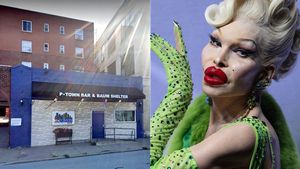Every year, the School of the Art Institute Chicago rolls out a fresh, new lineup of promising fashion talent. These graduates represent both the superficial and sociopolitical future of design, informed by what newcomers find important and therefore implement in their own practice. SAIC students this spring were particularly attuned to gender, investigating how clothing can help dismantle the binary and assert more inclusive, liberated style. Below, meet three breakout designers from SAIC's graduating class, who're each paving the way for non-binary fashion.
Natalie Castro

Known for purveying a joyous, exaggerated attitude through her whimsical designs, Natalie Castro's senior collection recalls the most carefree time in every person's life: childhood. "My concept is inspired by the nature of children," Castro says. "Children have unique traits that are unmarred by society's conventions. They are joyful, uninhibited, playful and unassuming."
Titled No Worries, No Rules, Castro's childlike debut exists outside boring learned biases, which we've developed as socialized adults. "Children live by no rules," she says. "A skirt can be [a] jacket, hat or purse to a child. These attributes are too often lost once we start growing up."
Castro's collection captures the spirit of someone wanting to keep their childhood self close, featuring an outrageous color palette, bulbous shapes that resemble kindergarten toys and activewear-inspired silhouettes. "My clothes are for people who are nonconformist, genuine, confident and carefree," Castro says, ushering in an ageless, genderless perspective on fashion.
Oscar Chen

Born and raised in Shanghai, Oscar Chen questions everything through fashion, specifically analyzing where western culture collides and, at times, aligns with Chinese communist ideologies. His senior collection, titled No Homo, is aptly charged with social commentary, pulling inspiration from dramatic LGBTQ provocateurs, such as Leigh Bowery, and juxtaposing them against traditional masculinity.
"I see fashion as social confrontation, and contend that every question we project onto fashion leads to a question about social construction," Chen says of his design practice. In the case of No Homo, the rising SAIC alumnus dissects and dismantles heteronormative sex appeal created within our patriarchy. Looking at how Bowery presented his sexuality, Chen marries the same queer theatricality of costumes with classic menswear.
"I hope to create a new category of garments that are non-binary, genderless, sensual and fun," Chen says, underlining his nuanced range of delicate ballet-influenced looks. "But the fun is also serious--I want to confront ideas of what normal is."
Sappho Finnegan

"I believe that fashion represents the culture in which it is created," says Sappho Finnegan, who grew up in the San Francisco Bay Area, where she developed a fascination with the way individuals publicly express themselves in contained social structures. Naturally, her senior collection is armed with a subversive alt attitude, called Nope, Not 4 You, and designed to explore gender roles.
For Finnegan, clothing operates as "a vital gear wheel that can be turned to prove a point, show an injustice and highlight beauty." Her breakout range, which shields the models' faces and disguises their natural gendered figures, wrestles with all three points, begging the viewer to define masculinity and femininity. "Can the lines be blurred, enabling masculinity to be feminine and femininity to be masculine?" Finnegan probes.
The designer's models aren't people, they're characters--ideas built to be defiant and completely free of social constructs. Finnegan says her characters "both embrace and defy societal taboos," ultimately developing their own non-binary definition of self and reminding spectators that individual presentation isn't for anyone but the individual--Nope, Not 4 You.
Photography: Grace DuVal & Julian Spring




























































